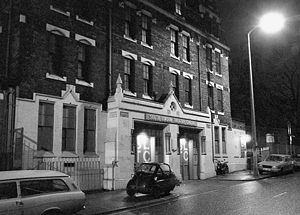SLT History
History of the South London Theatre
The South London Theatre is a Community theatre in West Norwood in the London Borough of Lambeth, England. Founded in October 1967 (as the South London Theatre Centre), it became a busy theatre venue, presenting over 22 shows annually in two auditoria: the 100 seater proscenium arch Bell Theatre and a smaller seater black box theatre named Prompt Corner, it also has a private basement bar open 364 nights a year which was host to regular social events. From October 2015 to April 2018, shows were temporarily produced at the Stanley Halls South Norwood in both the Lower Hall (larger than the Bell Theatre) and the Upper Hall which has the same capacity as Prompt Corner. This was to allow restoration following funding from the National Lottery Heritage Fund and others.
The plays produced include all genres; Shakespeare, comedy, classics, pantomime, musicals, and modern cutting-edge drama. New writing is particularly encouraged as are aspiring directors. There are plenty of roles behind scenes and help and encouragement is given to new members.
There is a very active youth group (South London Youth Theatre) as well as children's classes. The children have their own showcases and are also encouraged to participate in the main productions.
The Gothic revival style building was originally a fire station, built in 1881. It retains much of that original character, for example, it is the only fire station for horse drawn tenders which still has the look out tower and doors in place. The building should always retain its historic features as the frontage of the building is grade two listed. It had a short history as a fire station as it was built for horse-drawn fire engines and the new motorised appliances were too big for the doors, which could not be extended. The area behind these doors, where the appliances and horses were kept, was the Bell Theatre stage from 1967 to 2015. Between its life as a fire station and its role now as a theatre, the building was a hall for the neighbouring St Luke's parish church although there have long been rumours that it also served as an an illegal boxing venue.
The design for the conversion to a theatre was by Owen Luder (later to become President of the Royal Institute of British Architects on two occasions and a well-known Dulwich personality). The original design for the building was probably by Richard Pearsall, of the Metropolitan Board of Works, Architect's Department.
Like all old buildings it requires a lot of maintenance and a renovation was planned which should make the building fully accessible and able to accept performances from external theatre companies. A grant from the Heritage Lottery Fund was approved in July 2014 and work on this started in Autumn 2016.
The SLT Company moved out of the Old Fire Station in October 2015 to allow the building renovation to take place and found a temporary home at Stanley Halls in South Norwood.
Work finally began on the Old Fire Station in September 2016.
Now we have moved back (in Spring 2018) there is only one (larger) performance space, which is essentially an enlarged Prompt Corner. It has greater seating capacity, which is fully flexible (in fact the first few shows had completely different seating/acting area arrangements) and is higher so stage lighting is improved. There is room to build another auditorium when funds permit, but extra rehearsal space has enabled us to return to 2 shows a month. The second space will allow visiting productions at the same time as the two will be separated by the foyer.
The main move back was in April 2018, with the first production in the new space in the following week, though the Youth Group had performed in the new theatre space in March.
In March 2020 the effects of Coronavirus began to be felt at the Old Fire Station when the production of Do Not Disturb had to be postponed.
The South London Theatre is a member of the Little Theatre Guild of Great Britain.
See also
Gallery
- Photos
External links
- home page of the South London Theatre
- SLT twitter
- SLT's MySpace Page
- SLT Building Preservation Trust
- SLT on the Open House website
- Little Theatre Guild

